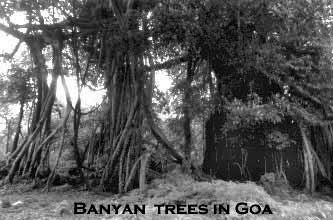|
It starts, and eons of dreams and phantasms collide with reality. I'm
flying Gulf Air into Bombay!
Listening to Om Kalthoom on the headphones, the islands of Crete and
Rhodes flash their summer ochre hue thirty-five thousand feet up at
my bewildered eyes. Syria, Jordan, Al-Nafud, a soft left, and we're
in Doha for an hour.
By that time, all the Arab women who left Paris in mini-skirts, hi-heels
and bare midriffs have turned into veiled and robed desert queens, so
propriety prevails!
When we finally take off for Bombay, the plane is mostly filled with
men: Indian laborers from the Emirates going back home for Indian Independence
Silver Jubilee celebrations later that week, and Arabs on the make looking
for trouble in Bombay, namely booze, gambling and loose women!!
And then, we land at dawn.
Seedy and deliquescent! That's Sahar International Airport in Mumbai
(the locals' name for Bombay, so I'll use that from here on end!), a
taste of things to come, but I don't know that yet. The good thing is
that Sahar airport immediately throws you into IT. Drab, dreary, dimly
lit interior. When I say dimly lit, don't go thinking romantic penumbra
or the soft dancing glow of exotic candles! What we have here are the
gloomy pulses of many fluorescent tubes running at half power, for that
uplifting and sickly greenish glow you'd normally associate with the
fourth sub-level of an underground parking garage, except it's dark.
Charming indeed!
Customs, immigration, Dollars into Rupees, and I'm outside into moist
heat and a rickety Airport-Downtown shuttle bus.
As I wait and look outside the window at my first Mumbai daybreak, palm
trees dripping warm water into oily monsoon puddles, I attract the attention
of my first of many beggars yet to come. After a few obligatory denials,
I figure I'll get rid of him with the smallest coin in my possession,
two rupees, for a big nickel donation.
Big mistake! He thanks me profoundly, and soon the word gets around
that a crazy "firangui" is giving out the crown jewels for
the asking. And before I can think "Let's go, Mumbai, let's go!",
my bus window is besieged by four kids, two cripples, a skin-and-bone
Holy Man, and a mother of several, all looking at me with haunted eyes,
one hand out going from their mouth to me with cries of "Baba,
Baba, please" in a gesture leaving 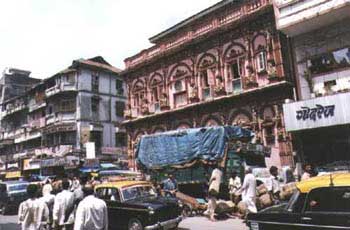 little
to the imagination! little
to the imagination!
Salving my rapidly rising western guilt, the bus presently departs,
and after forty five minutes of hovels and shanty towns, I see India
squatting with a water pitcher, defecating in unison by the side of
the road, oblivious to passing traffic and pedestrians, then proceeding
to brush its teeth and doing its morning ablutions with water from nearby
puddles!
The bus eventually stops at a big intersection where we all alight.
At a loss as to what's next, the driver answers my query by vaguely
pointing to a high-rise in the southeast, saying "Taj Mahal Hotel
over there!", before driving off into that blue morning diesel
mist! So here I am, barely an hour in Mumbai and already lost, walking
in the direction of a landmark not my destination, wondering "What
the fuck!!!".
The Taj Mahal is one of the grandest palace hotels in India, a testimony
to the Olden Glory days of the British Raj, where I will not be staying,
what with single A/C rooms going for $300 and up per night. Instead,
I aim for the Apollo, just around the corner. No luck, no vacancies!
So I retreat to my original choice where a reservation awaits me, the
Sahil Hotel, four kilometers north in Mumbai Central, which seems to
impress my cab driver to no end!
Rising behind a row of huts and two dumpsters oozing miasmic juices
are the Sahil's ten concrete stories. After checking into a clean A/C
room, I take my courage in both hands and go back outside for my first
full, extended encounter with Mumbai's sea of multi-colored saris, smells
of sandalwood incense and rotting offal, olfactory waves of curry and
feces battling the heady fragrances of jasmine and gardenia.
And it's only 9AM!!
PEOPLE
To say that Indians are friendly would be an understatement!
Discounting beggars and people trying to sell me something, never have
I seen so many people paying so much attention to me at all time. Smiles
always lighting up their faces, they wanted to know my name, where I
came from, and would I please take their picture?!
Even though I traveled on a U.S. passport, I told them I was French,
which seemed to be an answer they liked: "Paris, Eiffel Tower,
Brigitte Bardot, Jacques Chirac (what!?!)", the ol' cliches seem
to cross space and time without a hitch!
In Mysore I met two local hip and unemployed computer grads who blew
my French mind telling me they liked Magma, Telephone, Les Negresses
Vertes and Mano Negra!!
When I say Indians were friendly to me, I should specify Indian MEN
(no, not THAT kind of friendliness!)!!
Women were another matter. For a time, I thought a pissed-off sadhu
had cursed me with a spell of invisibility! Not a glance, not any acknowledgement,
my charmer smile and friendly deep-voiced "Hello" notwithstanding!
Only if I were buying something from her, would a woman smile at me!
-"Forget Indian women" friends told me. "Go for the Anglo
tourists!" they said. Well, it was monsoon season, and I was the
only westerner not on the Costa Brava, or Rome and Capri, for I saw
nary a one!
POVERTY
Coming to terms with the abject misery that is the daily lot of countless
thousands (millions is more like it, but you can only see thousands
at a time!), has to be the hardest task facing the first time westerner
in India. Our soft and cushy sensibilities render us unaccustomed to
take the sight of so many hungry people in rags with a nonchalant shrug
and go on our merry way. That many of these poor people belong to beggar
castes whose ordained duty in the dharma is to beg, and yours to give,
doesn't really help much. I lasted two days in the hell-hole that is
Mumbai and decided to go to Aurangabad and the Ellora caves. The Tapovan
Express to Aurangabad left Victoria Terminus, a chef-d'oeuvre of Indo-Moghul-Anglo-Gothic
kitsch you have to see to believe, at 6:30AM, only fifteen minutes late.
The suburban slums, in their defecating morning, went by endlessly.
When we finally hit the countryside, colored in a multitude of monsoon
greens, Mumbai's filthy poverty turned into plain lack of everything.
Imagine a poor county in Mississippi in the nineteenth century, add
a fair helping of variegated diesel trucks and dilapidated buses, throw
in a cloud of mopeds and small motorbikes, many ox-pulled plows and
carts, and you might get an idea. Just an idea!
ELLORA, AURANGABAD, DAULATABAD FORT
(Click here for Photos)
Aurangabad is the railway head most convenient to reach the Ellora
and Ajanta caves, after an eight-hour trip from Mumbai, through Kalyan
Junction, Manmad, Nagarsul and other frontier-like small towns and villages.
Like all things in India, it is steeped in history and has seen better
days!
It is named after Aurangzeb (1659-1707), the last of the Great Mughal
emperor, and it was his capital when he ruled in the Deccan. Sprawling
and polluted by a sea of constantly honking rickshaws, it is home to
a special handicraft known as "Himroo", handloom cotton and/or
silk interwoven with a great variety of intricate designs, inspired
by the age-old patterns found in Ajanta and elsewhere in the area. Magnificent
weaves they are, and I splurged big time when I found out the state
emporium selling them took credit cards!
On the way to Ellora, one passes the famous medieval fortress of Daulatabad,
a rock-hewn citadel dominating the landscape, from a 600 ft. high mesa-like
plateau. Built in the twelfth century by Raja Bhillamraj, it was called
Deogiri, "the hill of the Gods", and was considered to be
invulnerable! European travelers of those days have described it as
the most powerful in India.
But it fell, nevertheless, to the Sultan of Delhi in 1308. When Muhammad
Tughlak ascended the Delhi throne, he was so taken by the fortress that
he decided to move his court and capital there, renaming it Daulatabad,
"the City of Fortune". A transplantation rather than a move,
he ordered the entire population of Delhi, men, women, children, old,
sick and dying, rich and poor alike, to move out en masse to the new
capital! No one was exempted, and the thousand-mile journey exacted
a terrible toll in human misery, and thousands of people perished on
the way.
And it was all in vain.
Fifteen or so years later, the Sultan regretted his decision and, repeating
his act of madness, he ordered the whole population to move back to
Delhi. Ah! the charms of absolute power!!
Eventually, the fortifications were extended, ramparts and bastions
were built, mounted with huge bronze cannons, several rings of walls
with battlements guarded the approach. Several inner walls with heavy
iron gates fitted with elephant spikes were encircled by a six kilometer
outer wall. Inside these walls is a 40 ft. deep moat, with a drawbridge,
leading to the original citadel. The plateau's solid rock sides were
then scraped vertically flat to a height of 250 ft., for extra added
unease of access. I'll pass on the outlandish defensive apparatus, suffice
it to say it bordered on sadism, and had it not been for treachery,
the fortress might indeed never have been taken!
Along with Hampi, Ellora and its Buddhist, Hindu and Jaina temple caves
have to rank as the supreme experience of the trip!
Each religious system, living side by side in harmony I might add, had
its own individual architectural style, and contains some of the most
elaborate carvings of Gods and Goddesses. 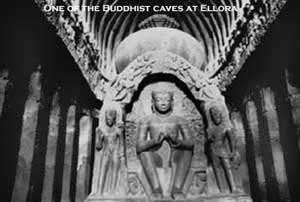
The Buddhist caves are the oldest (500-700 AD), and include several
"Vihara" and "Chaitya halls". Huge Buddhas seating
on Lion and lotus thrones supported by Naga figures with snake heads,
richly decorated facades, chapels inside galleries inside chapels, carved
roofs and pillars covered with ornate bas-reliefs, the diversity is
extraordinary.
The main Buddhist cave, No. 10, is dedicated to Vishwakarma, the Hindu
architect of the Gods, having no connection with the Buddhist pantheon!!
This commingling of concepts resulted finally in the absorption of Buddhism
in the current of Brahmanical thought, and its virtual extinction in
the land of its birth!
Of the Hindu caves, No. 16 is the most celebrated as the Kailasha,
Lord Shiva's mountain abode. It is one of India's most famous monuments,
a marvel of rock-cut architecture at the apex of technical skills. Excavated
in the eighth and ninth centuries AD , it is regarded as the greatest
monolithic structure in the world, combining immensity with grace, power
with jewel-like execution, and the awesome talents of hundreds of sculptors
and architects who created this grandeur out of the living rock!
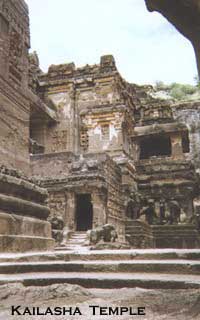 It is estimated that the task of quarrying and chiseling out its three
million cubic feet of rock took over a century! A square trench, over
a hundred feet deep and a hundred and fifty feet wide surrounds the
huge Shiva temple in the center. The three buildings in the spacious
court are connected by an overhead bridge, there are bold friezes of
life-size elephants, seemingly straining with the great burden of the
temple on their backs, the pyramidal roof has a three-tiered tower and
a projecting gable-front, and many panels show depictions of Shiva's
legend, featuring the god in various situations with his wife Parvati.
It is estimated that the task of quarrying and chiseling out its three
million cubic feet of rock took over a century! A square trench, over
a hundred feet deep and a hundred and fifty feet wide surrounds the
huge Shiva temple in the center. The three buildings in the spacious
court are connected by an overhead bridge, there are bold friezes of
life-size elephants, seemingly straining with the great burden of the
temple on their backs, the pyramidal roof has a three-tiered tower and
a projecting gable-front, and many panels show depictions of Shiva's
legend, featuring the god in various situations with his wife Parvati.
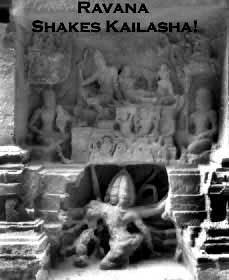 The
greatest masterpiece is known as "Ravana shaking Kailasha".
A central figure in the Ramayana, Ravana decided one day to display
his great strength by lifting Shiva's mountain abode on his head. By
way of an answer, Shiva did what you and I would do. He simply put his
toe down, and under the enormous pressure, Ravana became helplessly
trapped. An alarmed Parvati clings to her husband as courtiers and attendants
sit unperturbed by the shaking mountain, fully confident in Lord Shiva's
powers. The
greatest masterpiece is known as "Ravana shaking Kailasha".
A central figure in the Ramayana, Ravana decided one day to display
his great strength by lifting Shiva's mountain abode on his head. By
way of an answer, Shiva did what you and I would do. He simply put his
toe down, and under the enormous pressure, Ravana became helplessly
trapped. An alarmed Parvati clings to her husband as courtiers and attendants
sit unperturbed by the shaking mountain, fully confident in Lord Shiva's
powers.
Outside, monkeys move about, staring at the tourists, and I wonder
if Hanuman would approve.
EUROPEANS
Europeans in India can be roughly divided into two types:
the 20-30 year old crowd, travelling alone or in pairs, sometimes as
a quartet of meatheads (German and sometimes Americans), backpacking
their way through the sub-continent in time-honored fashion. Pretty
regular types here, they come, they go, no big deal.
Much more amusing is the second grouping: the family of four, with mom
and dad in their late forties, obviously reliving one last time afore
the bell tolls that transcendental Indo-Hippy acid meditation trip they
took together all those years ago, right out of school (grad or not!),
in the 1967-1972 halcyon days when everything was possible and Being
was more important than Having!
They dress the part.
From the ground up, we have: sandals/Birkenstocks, Indian straight-leg
yet loose-fitting cotton pants, white for dad, a pretty flower/paisley
print in a pastel blue shade for mom, matching top for both, all very
ethnic and real and so in touch with the soul of India! Mom even accents
it a bit with a long blue silk scarf rakishly draped around her neck,
one end dangling in front, the other in the back, for a striking effect
of elegant nonchalance. Rings, earrings, beads and jewelry of obvious
ethnicity and spiritual portent complete the picture.
The daughter, twenty and pretty, outfits herself just like mom, thread
for thread, a bit more garish in red or purple tones, more vibrant and
vital maybe, but still mom's carbon copy. The main difference between
them is that, back in Düsseldorf, Sheffield or Philadelphia, mom
dresses just like yours on the way to the office, whereas Peggy Sue,
third generation Dead Head Techno-ravette, is in her everyday cool best,
thirty full-circle fashion years apart!
The only clashing element here is Junior. Seventeen and pimply, as technoid
as sis but sans Dead, he probably felt too weird, fey and faggotty in
Indian garb! So it's sneaks, baggies, Stussy shirt and B-ball hat for
him, just in case he'd run into the guys at the big Shiva temple!
Other than the clothes, it's the very awkward feelings you get from
their body-english that strikes you.
Mom and dad obviously didn't remember it quite that way, feel heavier
and slower, can't quite recoup the awe of years past. It's just not
the same, however much they try! And the kids don't know what to make
of it. The ancient temples and monuments are way cool, of course, but
the constant and unavoidable filth and poverty are just too much for
their humanistic young minds.
- "Can't we help these people?" they think, "and shouldn't
we blame mom and dad and their generation for not curing such ills and
misery?"
And I find myself highly amused by the seeming existential travails
of this "Lost in Space on planet Earth" family, without robots,
but surely in the strangest of timeless time-warps, neither in the kid's
NOW nor the parent's THEN!
In Hampi I met a French woman, at the tail end of a year alone on the
road, having spent six months in Africa, not seeing white people for
weeks at a time, and coming to India to finally eat good food!!
We talked for an hour over tchai and vegetable thali, where she regaled
me with tales of malaria, parasites and dysentery! She was delighted
to meet a friendly compatriot, eager for conversation and the sharing
of adventures, in sharp contrast with the much-in-evidence and typical
attitude Euros have for one another, of one quick, unsmiling nod along
with a "Don't talk to me, whitey, I'm having an Alien experience"
peeved frown!
The third and final European encounter I'll share with you took place
on my last day there, at the Bangalore airport, waiting to board my
first of three homeward flights that day!!
Besides being the fifth largest city in India and its hi-tech "Silicon
Valley" and space sciences capital, Bangalore is also home to the
"Sri Sathya Sai Babai ashram". Well, it's really in Puttaparti,
200 kilometers away, but who's counting when you're scratching the Godhead!
The Baba thought of himself, at first, as the reincarnation of a Maharashtra
sadhu, then in the 60s, as an Avatar of Lord Shiva! Serious mystical
stuff, then, and quite mystical enough for the dozen or so Italians,
forty/fifty-something and beatific, also awaiting Indian Airlines flight
110 to Mumbai.
Clearly fresh off the Ashram, they wear the obligatory garb of Eastern
spiritual awakening, white linen pajama suits with long shirts and Birkenstocks,
and are fully laden with study books and mystic manifestoes, garlands
of flowers and pictures of the Baba.
Having received the Sage's knowledge, in exchange for hard currency
and devotion, they return home, full of wisdom and reason, I'm sure.
Never underestimate the spiritual cleansing power of a Swiss bank account,
especially when shrouded in the arcane inspirational cognition of Sri
MumboJumbocananda. Throw in a good serving of Tantric sex liberation,
all you can eat, it's included in the package, and there you have it,
Nirvana sulla Terra!
Ah, aging acid heads on a white man's burden guilt flashback, hoping
for solace and succor in that long-postponed Ashram trip, thirty years
after the Maharishi (or could it be Guru Maharaj Ji? Remember him? Is
he still the fifteen year-old perfect master?!?) planted that seed in
their ever so fertile and yearning angst-ridden mind!
-"What's that you said, Baba? Peace of mind? I'm OK, you're OK?
New Age bliss? Sign me up, Baba! Dollars, Swiss Francs, AMEX?"
Nevertheless, an air of sadness sporadically flickers on their faces.
Could they be saddened, even despondent, with leaving the Baba? Or could
it be a bit of post-tantricoïtal small death depression? Of course,
after so many days in the Baba's syncretic presence, as He opened their
third eye to the vibrancy of the cosmos, lightened their load and levitated
their money to some secret esoteric cavern on Grand Cayman, they may
very well have expected to fly back to Roma on their own power!
So, Flight 110 has to be a disappointment!!
FOOD
The French woman I met in Hampi was right. This is the place for culinary
delights, sublime spices and curried wonderment. India is heaven for
the vegetarian and a dandy place for the meat eater too. OK, so no beef
(on the plate, that is. Plenty on the hoof!), but mutton -don't get
squeamish calling it lamb, it's mutton!!- and chicken aplenty, in all
kind of biryani, tikkha, tandoori, mughlai, or other combinations, as
exquisite as they're endless. Karmically-correct vegetable thali, a
plateful of endless fragrances and subtle enchantments, spicy as you
wish. Large, naturally grown, ripe and juicy vegetables. Bananas in
all sizes, shapes and colors, mangoes and papayas, hairy-brown and smoothly
green coconuts offering you the milk of their kindness, napalm peppers,
green curlicued chilies, hellspawn capsicum, sweet Bun wrapped in betel
leaves, deep-fried pakodas and samosas sold at train stations, on street
corners and in the ravening dreams of my feverish hunger.
TRAVELS
Unless you' re living high on the hog and jetting everywhere, you will
experience the joy of Indian mass transit! Forget people on roofs and
dripping off overcrowded train cars the way you saw them in "The
Man Who Would Be King" or "Ghandi". Indian railways have
a computerized reservation system that worked every time I used it,
transit trains out of Mumbai were many and frequent, none were ever
too crowded, and I traveled 2nd class under ceiling-fan breezes.
Buses are another story.
City buses will be packed, always, and you do wonder why they bother
stopping to pick up more passengers.
"It's full already" you think.
But, hey, with 120 people in a 60-capacity bus, there's always room
for a dozen more! Forget standing behind the white line.
3 to 4 people will stand behind the driver and to his left and right,
straddling the gear shift! The only room left untouched is the ubiquitous
temple/shrine in the front under the rear-view mirror, where Ganesha,
Krishna, Shiva, or the local tutelary deity sits enthroned, festooned
with garlands of gardenias and bathed in incense smoke.
Short-distance buses will have a sound system blasting away and barely-padded
benches, and that's OK, since the cushioned seats in the long-haul coaches
will invariably be torn open and disemboweled!
Of course, they have a video set-up to make the long trips more bearable.
On a scheduled 12 hour ride that ended up taking 14 due to flat tires
(I helped!), engine problems (I pushed!), slow traffic, stray animals,
ambulating cattle, bombed-out roads and monsoon floods, it can be a
welcome diversion to while away the hours watching the latest Bollywood
production.
Travelling the 350 kilometers between Poona and Goa (in 14 hours, that
gives you an idea of the average speed!), we were treated to an Hindi/Kung
Fu/Kali extravaganza that went like this, as best I could tell, what
with my Hindi not being what it used to be.
Two brothers, Anjun and Vijay love each other and their mom very much,
and a wonderful production number is set-up to prove it. Close-ups of
loving glances, with mom center screen and the bros. on both side, and
a cast of hundreds dancing and singing paeans of brotherly love and
elder worship!
Meanwhile, a bad guy looking like Saddam Hussein, and his three honchos
(same look, THEY could be brothers too, for all I know) worship Kali
(fire breathing and ominous gyrations from the cast), and end up doing
unmentionable things to mom and killing our two heroes with much sword
action and gory, bloody close-ups, in an Indian approximation of the
samurai's Death of a Thousand Cuts!! I'm not entirely sure how that
came about, I must have been changing the tire at that moment!
Mom is devastated and disheveled, and runs to that same Kali temple
where she unleashes such heart-rending cries and mournful prayers that
the Ten-headed and Bloody-Tongued One is moved to grant her wish, namely
to reincarnate her brood. You know it worked because you hear the wail
of a new-born babe echoing through the temple dome!
For the next hour, we see mom aging in hopeful sorrow and the bros.
growing up separately, and as ENEMIES, fighting all the time in vibrant
hate!!
Anjun's romantic interest is about to be married to the bad guy's son,
when our two heroes arrive separately on the scene, and finally recognize
their kinship and former life when a bolt from the blue stops them as
they are about to fight each other in the enemy palace. They then proceed
to do karate mince meat of the bad guys.
Mom, who's aged thirty years since the beginning, recognizes her sons
who haven't changed at all and much happiness, rejoicing, singing and
dancing ensues. The End!
Several hours later, we enter the Goan rain forest with its red earth,
lianas and Banyan trees, parrots and monkeys.
The monsoon-sky cries without let-up.
|
 little
to the imagination!
little
to the imagination! 
 It is estimated that the task of quarrying and chiseling out its three
million cubic feet of rock took over a century! A square trench, over
a hundred feet deep and a hundred and fifty feet wide surrounds the
huge Shiva temple in the center. The three buildings in the spacious
court are connected by an overhead bridge, there are bold friezes of
life-size elephants, seemingly straining with the great burden of the
temple on their backs, the pyramidal roof has a three-tiered tower and
a projecting gable-front, and many panels show depictions of Shiva's
legend, featuring the god in various situations with his wife Parvati.
It is estimated that the task of quarrying and chiseling out its three
million cubic feet of rock took over a century! A square trench, over
a hundred feet deep and a hundred and fifty feet wide surrounds the
huge Shiva temple in the center. The three buildings in the spacious
court are connected by an overhead bridge, there are bold friezes of
life-size elephants, seemingly straining with the great burden of the
temple on their backs, the pyramidal roof has a three-tiered tower and
a projecting gable-front, and many panels show depictions of Shiva's
legend, featuring the god in various situations with his wife Parvati.
 The
greatest masterpiece is known as "Ravana shaking Kailasha".
A central figure in the Ramayana, Ravana decided one day to display
his great strength by lifting Shiva's mountain abode on his head. By
way of an answer, Shiva did what you and I would do. He simply put his
toe down, and under the enormous pressure, Ravana became helplessly
trapped. An alarmed Parvati clings to her husband as courtiers and attendants
sit unperturbed by the shaking mountain, fully confident in Lord Shiva's
powers.
The
greatest masterpiece is known as "Ravana shaking Kailasha".
A central figure in the Ramayana, Ravana decided one day to display
his great strength by lifting Shiva's mountain abode on his head. By
way of an answer, Shiva did what you and I would do. He simply put his
toe down, and under the enormous pressure, Ravana became helplessly
trapped. An alarmed Parvati clings to her husband as courtiers and attendants
sit unperturbed by the shaking mountain, fully confident in Lord Shiva's
powers. 